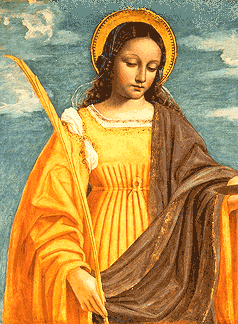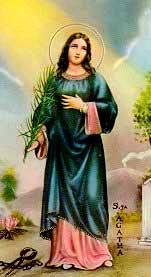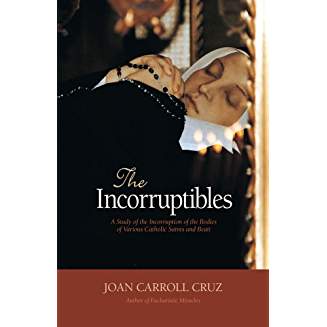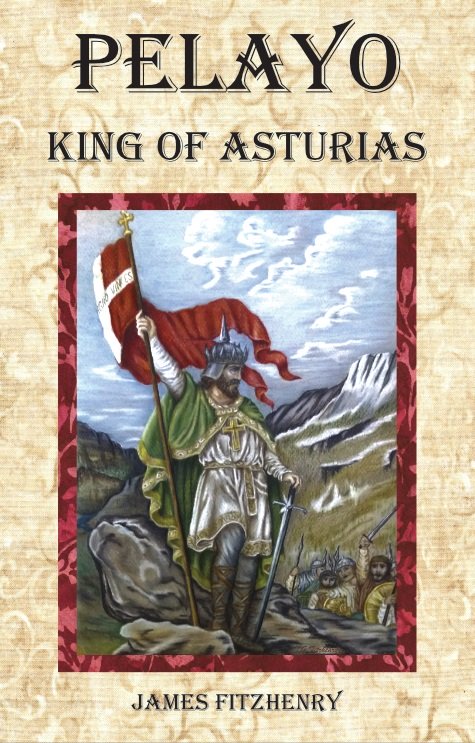
St Agatha
Virgin and Martyr
Died: 251
This holy virgin and martyr, St Agatha, is held in great veneration by the Greek as well as the Latin Church; and although her original Acts have not been preserved, many well-authenticated facts concerning her martyrdom are found in the Bollandists, Surius, and others.
St Agatha was a native of Sicily, and descended of a noble and opulent family. These circumstances, added to her extraordinary beauty, inflamed Quintianus, a man of consular dignity, with such love of her, that he resolved to compel her to become his wife. The edicts of the emperor Decius against the Christians having been published, he ordered Agatha to be arrested as a Christian, and conducted to Catania, where he then resided.
The holy virgin, St Agatha, having heard the proclamation against the Christians, retired to a solitary place in order to avoid the snares of Quintinus, concerning which she had received some intimation.
The emissaries of the governor, however, discovered her place of concealment, and after having been arrested, she prayed after the following manner: “O Jesus Christ, Lord of all things, Thou seest my heart, and knowest my desire, which is to possess only Thee, since I have consecrated myself entirely to Thee. Preserve me, dear Lord, from this tyrant, and enable me to overcome the devil, who layeth snares for my soul.
When St Agatha appeared before Quintianus, in order the more easily to overcome her modesty, he gave her up to Aphrodisia, an abominable woman, who, together with her daughters, publicly professed immodesty. In her infamous house the saint suffered greater torture than the darkest and most fetid dungeon could afford. All the arts of Aphrodisia and her partners in crime were unceasingly applied, in order to induce the saint to comply with the wishes of Quintianus; but Agatha, who from her infancy had been consecrated to Jesus Christ, was enabled by his divine grace to overcome all their attempts.
Quintianus, having been informed that the efforts of Aphrodisia for an entire month had been employed in vain, commanded that the saint should be again brought before him. He upbraided her, that, being a free woman and noble, she had allowed herself to be seduced into the humble servitude of the Christians.
The holy virgin courageously confessed that she was a Christian, and that she knew of no nobility more illustrious, nor liberty more real, than to be a servant of Jesus Christ.
Quintianus, irritated at her rebuke, commanded her to be buffeted and led to prison. The following day she was again summoned, and asked whether she had resolved to save her life.
St Agatha replied: “God is my life and my salvation.” The governor then put her to the torture, which was executed with barbarous cruelty.
Quintianus then remanded the saint to prison, commanding that her wounds should be left undressed, in order that she might expire under the torture.
But at midnight St. Peter appeared to her in a vision, perfectly cured her wounds, and freed her from all pain; during the entire of that night there appeared in the interior of the prison so resplendent a light that the guards fled in terror, leaving the door of her dungeon open, so that she could have escaped, as the other prisoners advised her, but that she was unwilling, as she said, to lose by flight the crown which was being prepared for her in heaven.

St Agatha
Virgin and Martyr
Quintianus, nothing moved by her miraculous cure, but on the contrary more irritated, after four days devised new torments for the saint.
He commanded that she should be rolled over broken tiles, mixed with burning coals; but she endured all with constancy; and while the tyrant was planning fresh torments, the saint, perceiving that her life was drawing to a close, made the following prayer:
“O Lord, my Creator, who hast preserved me from infancy, hast given me strength to overcome these torments, and hast taken from me the love of the world, receive now my soul. It is time that I should at last pass from this miserable life to the fruition of Thy glory.”
Just as she had finished these words, she tranquilly expired, and went to be united to God, to praise him and love him forever. This happened in 251. Her name is mentioned in the Canon of the Mass.
*Story told by St. Alphonsus de Liguori
The incorrupt body of St Agatha was transferred to Constantinople in the 11th century, and then returned to Catania. The body is now preserved in different reliquaries. "The arms, legs, and breasts are preserved in a glass case in an incorrupt condition, although rather dried and dark after more than 17 centuries. The skull and principal relics are at Catania, enclosed in an effigy on which rests a costly jeweled crown. The reliquary consists of the figure of the Saint from the head to the waist and is situated in an upright position. The figure is entirely covered with precious gems, rings, bracelets, pins, chains, and jeweled flowers and crosses..."
* "The Incorruptibles", Cruz

Continuously popular since it first appeared in 1977, The Incorruptibles remains the acknowledged classic on the bodies of saints that did not undergo decomposition after death. Many remained fresh and flexible for years, or even centuries. After explaining both natural and artificial mummification, the author shows that the incorruption of the saints' bodies fits neither category but rather constitutes a much greater phenomenon that is unexplained by modern science to this day. The author presents 102 canonized saints, beati, and venerables, summarizing their lives, the discovery of their incorruption, and investigations by Church and medical authorities.
The incorruptible bodies of saints are a consoling sign of Christ s victory over death, a confirmation of the dogma of the Resurrection of the Body, a sign that the Saints are still with us in the Mystical Body of Christ, and proof of the truth of the Catholic Faith—for only in the Catholic Church do we find this phenomenon. Impr. 342 pgs 33 Illus, PB.
Return to Incorruptible Saints Page
Return to Saints Page
Return to Martyrs Page
Return to Roman Catholic Saints Homepage
NOW AVAILABLE!!
Pelayo's resistance initiated the nearly 800-year-long Reconquista to take back his country from the ruthless invader who had conquered his homeland and sought to erase his culture and his faith. His actions would lay the foundations of a Kingdom for Christ that would eventually reach around the world and spread the Catholic faith to millions of souls. Read more...
Please help us continue to bring high quality books to our readers at the lowest possible price! Click the link below! Thank you!
Now Available!
Defenders of Christendom
Battles - Honor - Miracles!
This book is filled with
amazing stories of little-known
Catholic heroes presenting
spectacles of bravery and
valor never exceeded in all the annals of history.
Demonstrating his
gallantry through daring feats
of arms, the knight's faith,
coupled with his marvelous
courage, made him nearly
invincible on the field
of battle.
read more . . .
Defenders of Christendom is
Learning to Love God
Especially for young children -
Now available as an e-book!
Available for only $2.99 US
as an ebook download.
Also available in Spanish!
The exciting life story of
the holy Catholic knight
known as El Cid!
Available for only
$22.95
The amazing life story of the
little known incorrupt saint
- King Fernando III!
This highly acclaimed book is
inspirational to young men
and a guide to building a strong
masculine, Catholic character!
Also available as softback!








